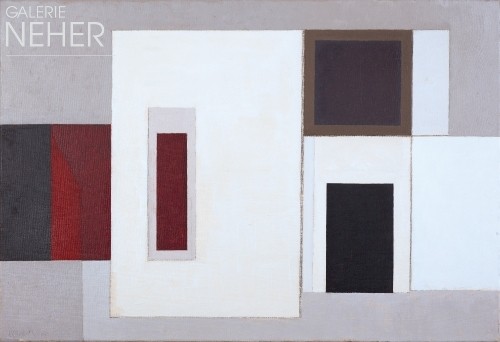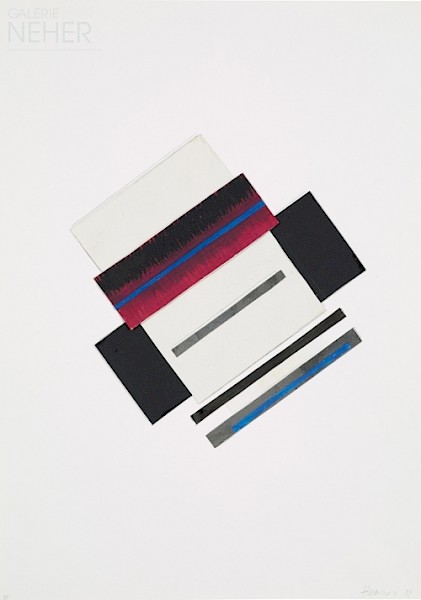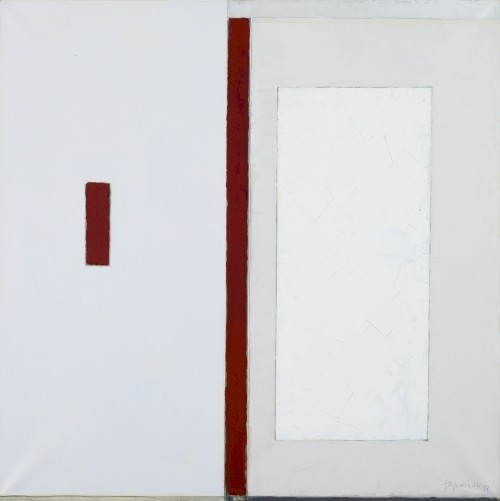Heinrich Siepmann
* 30 11 1904 | Mülheim an der Ruhr
† 16 12 2002 | Mülheim an der Ruhr
Heinrich Siepmann, co-founder of the Recklinghausen artist group junger westen following the Second World War, is considered one of the most important representatives of the second generation of constructivists in Germany. The multifaceted cosmos of his geometric pictorial language is characterised by a harmonious pictorial architecture and balanced colour design in the field of tension between formal order and lyrical emotionality. Collages of cut up paper, card, cardboard or found items like coffee foil packaging accompanied his paintings on canvas as free fields of experimentation since the beginnings of his artistic career.
Works by Heinrich Siepmann
Vita Heinrich Siepmann
1904
Born in Mülheim on the Ruhr.
1920s
Initial occupation with contemporary art through friendship with the painter Max Schultze-Sölde. Siepmann initially felt an affinity with artists like Vincent van Gogh and Käthe Kollwitz.
1925–27
Artistic training at the Folkwangschule, Essen. He studied with Joseph Enseling, Karl Kriete and Josef Urbach and experimented with various techniques and styles.
1926
A noteworthy, non-representational design for a glass window with geometrical area segments originated under instruction from Karl Kriete.
1927
He quit his studies after the summer semester, as the areas of focus did not correspond with his artistic interests.
1928–32
Siepmann worked as a freelance painter and commuted between Mülheim and Berlin, but ultimately could not find his place in the capital city. He captured impressions of the metropolis with ink and pencil in sketchbooks.
1932
Final return to Mülheim.
He discovered various regions of Germany and the Netherlands with the help of travel scholarships. He captured his impressions in watercolours, pencil studies and graphic works: the East Frisian coast, Lübeck, Lake Walchen, Xanten and Amsterdam. The works were shown in group exhibitions in the Städtisches Museum Mülheim and in the Museum Folkwang, Essen.
1937
One-year stay in Munich. He copied the works of Old Masters in the Alte Pinakothek and practised their painting techniques.
1938
He attended the Staatsschule für angewandte Kunst (State School for Applied Arts) in Nuremberg and designed rugs with motifs from Till Eulenspiegel there.
Before he was conscripted for military service, he spent a year in Heilbronn and copied a painting of the painter Joseph Winkelierer, a member of the Düsseldorf school of painting, as a commission for the city of Mülheim. The copy was shown for Pentecost of 1941 in the Städtisches Museum Mülheim.
1941–45
Siepmann initially served as a bridge guard on the Rhine and was later redeployed to Flanders, France and Italy. He continued to produce landscape watercolours and local views. A certain clear, constructive pictorial language was already recognisable in his art.
1945
He returned to Mülheim in the summer via various allied POW camps.
First exhibition of his works in the city council room of the Duisburg city hall with Heinrich Gertges.
1948
Marriage to Trudel Kiwitz.
He produced paintings of scenes of destruction, representations of dancing marionettes, masks and death, as well as many still lifes.
Together with Emil Schumacher, Karl Otto Götz and Kurt Lehmann, he was awarded the junger westen art prize of the city of Recklinghausen.
Siepmann founded the junger westen group together with his artist colleagues Gustav Deppe, Thomas Grochowiak, Ernst Hermanns, Emil Schumacher and Hans Werdehausen with the goal of re-establishing contact with international modernity after National Socialism and the devastation of the war. The first presentation of their works took place from 4 September to 3 October in a hall of the Hotel Engelsburg in Recklinghausen.
The travelling exhibition Französische Abstrakte Malerei (French Abstract Painting) was to be a defining experience for Siepmann. Here he found non-representational art, which inspired him in his search for his own pictorial language for his work with geometric forms.
1950–57
The works of these years were defined by floating colour areas and exciting compositions with linear elements.
1953
Siepmann became a member of the Westdeutscher Künstlerbund (West German Association of Artists).
His son Heinrich was born on 24 June.
1954
Siepmann was awarded the junger westen art prize of the city of Recklinghausen.
1955–59
The concentration on the formal aspects in Siepmann’s paintings now made way for an intensified focus on the material presence of the paint. The forms dissolved, and a nearly dappled style of painting arose.
1956
He became a member of the Deutscher Künstlerbund (German Association of Artists).
1959–69
Non-representational paintings influenced by Tachism were produced in the early 1960s, with titles like Im Wirbel (In the Vortex) or Spiralthema (Spiral Theme).
1962
He was honoured with the Ruhr prize for art and science of the city of Mülheim on the Ruhr.
1964
Siepmann was commissioned to design a tapestry for the Ruhrfestspielhaus in Recklinghausen and recollected the geometric possibilities for representation of an earlier work from 1954 with the title Weißer Dreiklang (White Triad). The rug with the title of the same name was completed in 1965 and is now in the holdings of the Kunsthalle Recklinghausen. It is still found in the Ruhrfestspielhaus.
1970
Start of a constructive phase and a turn to considerably reduced compositions, in which emotion receded in favour of reason in the design process. The first constructive collages were produced in the 1970s.
1979
Karl Ernst Osthaus Prize of the city of Hagen and Art Prize of the Artists of Düsseldorf.
1980
Guest residency in the Villa Romana, Florence.
1981
Grand Prix of the 3rd International Biennial Print in Seoul, South Korea.
1989/90
Retrospectives in Bochum, Düsseldorf and Ahlen.
At the end of the 1980s, he began to design the canvas beyond the limits of the frame.
1994
Distinguished with the Ring of Honour of the city of Mülheim on the Ruhr.
1997
Siepmann was honoured with the Ida Gerhardi Prize, Lüdenscheid.
1999
Ferdinand Ullrich published the volume Heinrich Siepmann. Monographie. Werkverzeichnis der Gemälde on the occasion of a major exhibition in the Zollverein in Essen and in the Kunsthalle Recklinghausen.
2001
Extensive show in the State Russian Museum in Saint Petersburg.
2002
Heinrich Siepmann died in December in Mülheim at the age of 98.


